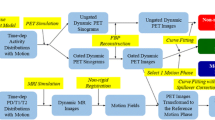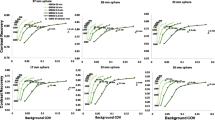Background
To perform kinetic modelling quantification, PET dynamic data must be acquired in short frames, where different critical conditions are met. The accuracy of reconstructed images influences quantification. The added value of Time-Of-Flight (TOF) and Point Spread Function (PSF) in cardiac image reconstruction was assessed.
Methods
A static phantom was used to simulate two extreme conditions: (i) the bolus passage and (ii) the steady uptake. Various count statistics and independent noise realisations were considered. A moving phantom filled with two different radionuclides was used to simulate: (i) a great range of contrasts and (ii) the cardio/respiratory motion. Analytical and iterative reconstruction (IR) algorithms also encompassing TOF and PSF modelling were evaluated.
Results
Both analytic and IR algorithms provided good results in all the evaluated conditions. The amount of bias introduced by IR was found to be limited. TOF allowed faster convergence and lower noise levels. PSF achieved near full myocardial activity recovery in static conditions. Motion degraded performances, but the addition of both TOF and PSF maintained the best overall behaviour.
Conclusions
IR accounting for TOF and PSF can be recommended for the quantification of dynamic cardiac PET studies as they improve the results compared to analytic and standard IR.









Similar content being viewed by others
References
Herzog BA, Husmann L, Valenta I, Gaemperli O, Siegrist PT, Tay FM, et al. Long-term prognostic value of 13N-ammonia myocardial perfusion positron emission tomography added value of coronary flow reserve. JACC 2009;54:150-6.
Fiechter M, Ghadri JR, Gebhard C, Fuchs TA, Pazhenkottil AP, Nkoulou RN, et al. Diagnostic value of 13N-ammonia myocardial perfusion PET: Added value of myocardial flow reserve. J Nucl Med 2012;53:1230-4.
DeGrado TR, Bergmann SR, Ng CK, Raffel DM. Tracer kinetic modeling in nuclear cardiology. J Nucl Med 2000;7:686-700.
Yu M, Nekolla SG, Schwaiger M, Robinson SP. The next generation of cardiac positron emission tomography imaging agents: Discovery of flurpiridaz F-18 for detection of coronary disease. Semin Nucl Med 2011;41:305-13.
Kinahan PE, Rogers JG. Analytic 3D image reconstruction using all detected events. IEEE Trans Nucl Sci 1989;36:964-8.
Søndergaard HM, Madsen MM, Boisen K, Bøttcher M, Schmitz O, Nielsen TT, et al. Evaluation of iterative reconstruction (OSEM) versus filtered back-projection for the assessment of myocardial glucose uptake and myocardial perfusion using dynamic PET. Eur J Nucl Med 2007;34:320-9.
Visvikis D, Griffiths D, Costa DC, Bomanji J, Ell PJ. Clinical evaluation of 2D versus 3D whole-body PET image quality using a dedicated BGO PET scanner. Eur J Nucl Med 2005;32:1050-6.
Riddell C, Carson RE, Carrasquillo JA, Libutti SK, Danforth DN, Whatley M. Noise reduction in oncology FDG PET images by iterative reconstruction: A quantitative assessment. J Nucl Med 2001;42:1316-23.
Wang CX, Snyder WE, Bilbro G, Santago P. Performance evaluation of filtered backprojection reconstruction and iterative reconstruction methods for PET images. Comput Biol Med 1998;28:13-24.
Reilhac A, Tomeï S, Buvat I, Michel C, Keheren F, Costes F. Simulation-based evaluation of OSEM iterative reconstruction methods in dynamic brain PET studies. Neuroimage 2008;39:359-68.
Walker MD, Asselin MC, Julyan PJ, Feldmann M, Talbot PS, Jones T, et al. Bias in iterative reconstruction of low-statistics PET data: Benefits of a resolution model. Phys Med Biol 2011;56:931.
Conti M. Focus on time-of-flight PET: The benefits of improved time resolution. Eur J Nucl Med 2011;38:1147-57.
Karp JS, Surti S, Daube-Witherspoon ME, Muehllehner G. Benefit of time-of-flight in PET: Experimental and clinical results. J Nucl Med 2008;49:462-70.
Conti M. Why is TOF PET reconstruction a more robust method in the presence of inconsistent data? Phys Med Biol 2011;56:155.
Bettinardi V, Castiglioni I, De Bernardi E, Gilardi MC. PET quantification: Strategies for partial volume correction. Clin Transl Imaging 2014;2:199-218.
Le-Meunier L, Slomka PJ, Dey D, Ramesh A, Thomson LE, Hayes S, et al. Enhanced definition PET for cardiac imaging. J Nucl Cardiol 2010;17:414-26.
Armstrong IS, Tonge CM, Arumugam P. Impact of Point Spread Function modeling and time-of-flight on myocardial blood flow and myocardial flow reserve measurements for rubidium-82 cardiac PET. J Nucl Cardiol 2014;21:1-8.
Bettinardi V, Presotto L, Rapisarda E, Picchio M, Gianolli L, Gilardi MC. Physical performance of the new hybrid PET/CT discovery-690. Med Phys 2011;38:5394-411.
M Iatrou, SG Ross, RM Manjeshwar, CW Stearns, A fully 3D iterative image reconstruction algorithm incorporating data corrections. In: IEEE Nuclear Science Symposium Conference Record, vol. 4, p. 2493-2497.
Alessio AM, Stearns CW, Tong S, Ross SG, Kohlmyer S, Ganin A, Kinahan PE. Application and evaluation of a measured spatially variant system model for PET image reconstruction. IEEE Trans Med Imaging. 2010;29:938-49.
Presotto L, Bettinardi V, Petta P, Gilardi MC. A compact dynamic phantom to assess the effect of motion in cardiac PET and SPECT studies. In: Nuclear Science Symposium and Medical Imaging Conference (NSS/MIC), 2012 IEEE, p. 2638, 2642; 2012.
Alessio AM, Kohlmyer S, Branch K, Chen G, Caldwell J, Kinahan P. Cine CT for Attenuation Correction in Cardiac PET/CT. J Nucl Med 2007;48:794-801.
Cheng NM, Yu CT, Ho KC, Wu YC, Liu YC, Wang CW, et al. Respiration-averaged CT for attenuation correction in non-small-cell lung cancer. Eur J Nucl Med Mol Imaging 2009;36:607-15.
Defrise M, Casey ME, Michel C, Conti M. Fourier rebinning of time-of-flight PET data. Phys Med Biol 2005;50:2749.
Conti M, Bendriem B, Casey M, Chen M, Kehren F, Michel C, Panin V. First experimental results of time-of-flight reconstruction on an LSO PET scanner. Phys Med Biol 2005;50:4507.
Cerqueira MD, Weissman NJ, Dilsizian V, Jacobs AK, Kaul S, Laskey WK, et al. Standardized myocardial segmentation and nomenclature for tomographic imaging of the heart. Circulation 2002;105:539-42.
Gould KL, Pan T, Loghin C, Johnson NP, Guha A, Sdringola S. Frequent diagnostic errors in cardiac PET/CT due to misregistration of CT attenuation and emission PET images: A definitive analysis of causes, consequences, and corrections. J Nucl Med 2007;48:1112-21.
Dorbala S, Di Carli MF, Delbeke D, Abbara S, DePuey EG, Dilsizian V, et al. SNMMI/ASNC/SCCT guideline for cardiac SPECT/CT and PET/CT 1.0. J Nucl Med 2013;54:1485-507.
Hutchins GD, Caraher JM, Raylman RR. A region of interest strategy for minimizing resolution distortions in quantitative myocardial PET studies. J Nucl Med 1992;33:1243-50.
Polycarpou I, Thielemans K, Manjeshwar R, Aguiar P, Marsden PK, Tsoumpas C. Comparative evaluation of scatter correction in 3D PET using different scatter-level approximations. Ann Nucl Med 2011;25:643-9.
Disclosure
All the authors have nothing to disclose.
Author information
Authors and Affiliations
Corresponding author
Appendix
Appendix
The Reconstruction Algorithms
All the iterative algorithms used in this work were provided by the scanner manufacturer. They are all based on a 3D-OSEM algorithm, with all the relevant corrections implemented in the iterative scheme as
where I i+1 n and I i n are the values of the nth image pixel of the images I at the ith + 1 and ith iteration. P m is the mth sinogram element, M m is a matrix accounting for all the multiplicative correction to be applied to the mth sinogram element (normalisation, dead-time and attenuation) and A is the matrix of the additive corrections accounting for random and scatter coincidences. The matrix H account for the system geometry, which represent the probability for a photon emitted from the nth image pixel to be recorded in the mth projection bin.
The PSF modelling is achieved by modifying the H operator to H′ such that \( H^{\prime}_{m,n} = \sum\limits_{k} {D_{m,k} H_{k,n} } , \) where D represents the detector response model. Note that the PSF has been implemented as a spatially variant model in the sinogram domain.
The iterative algorithms, including TOF, have a basic implementation, like the OSEM counterpart, but the events are weighted according to the TOF probability distribution by a TOF kernel T, which estimates the contribution from each voxel n, to the time bin t of the projection bin m considered
The multiplicative corrections and the PSF implementation work as in the non-TOF case while the additive correction requires TOF to be taken into consideration (i.e., the random coincidences are split equally between each time bin, while the scatter distribution is time dependent).
Scatter coincidences are iteratively estimated using a 3D model-based scatter simulation30 that computes the fraction of the single scatter, following a convolution procedure is used to estimate multiple scatter, finally scaling the results to the emission tails. For TOF reconstruction, the same procedure is used but the simulation account for the distribution along the temporal dimension. Random coincidences are estimated from detectors single count rates.
The RP algorithm we used was also provided by the scanner vendor. The filters were based on what described by Kinahan and Rogers.5 Scatter and random coincidences were estimated with the same algorithms as for OSEM and, subsequently, subtracted from the sinogram.
The TOF-FORE-FBP algorithm was implemented off-line by our group using a research-tool software provided under a research collaboration with GEMS which uses the same routines as in the PET scanner. The implementation it is based on the work by Defrise et al24 for the TOF implementation of FORE and the TOF-FBP procedure uses the same filter described by Conti et al25 to reconstruct the rebinned 2D-TOF sinograms. Scatter coincidences were simulated in the same way of the TOF iterative algorithms in 3D. Once estimated, scatter and random coincidences were subtracted from the 3D-TOF sinograms. Subsequently, the sinogram was corrected for detector geometry, dead-time, normalisation and attenuation. Finally, the 3D data were rebinned to 2D using FORE, before the TOF-FBP reconstruction.
Rights and permissions
About this article
Cite this article
Presotto, L., Gianolli, L., Gilardi, M.C. et al. Evaluation of image reconstruction algorithms encompassing Time-Of-Flight and Point Spread Function modelling for quantitative cardiac PET: Phantom studies. J. Nucl. Cardiol. 22, 351–363 (2015). https://doi.org/10.1007/s12350-014-0023-1
Received:
Accepted:
Published:
Issue Date:
DOI: https://doi.org/10.1007/s12350-014-0023-1




